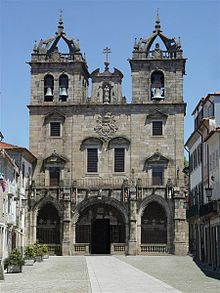Braga Cathedral
| Braga Cathedral Sé de Braga |
|
|---|---|

Main façade of Braga Cathedral. The entrance gallery (galilee) with three arches is gothic (end of 15th century), but the towers and upper storeys are early baroque (17th century).
|
|
| Basic information | |
| Location | Braga, Portugal |
| Geographic coordinates | 41°33′00″N 8°25′38″W / 41.5499°N 8.42736°WCoordinates: 41°33′00″N 8°25′38″W / 41.5499°N 8.42736°W |
| Affiliation | Roman Catholic |
| District | Archdiocese of Braga |
| Ecclesiastical or organizational status | Cathedral |
| Architectural description | |
| Architectural type | Church |
| Architectural style | Gothic, Manueline, Baroque |
The Cathedral of Braga (Portuguese: Sé de Braga) is one of the most important monuments in the city of Braga, in Northern Portugal. Due to its long history and artistic significance it is also one of the most important buildings in the country. It is the seat of the Archdiocese of Braga.
The Diocese of Braga dates from the 3rd century AD, being one of the oldest in the peninsula and the centre for the Christianisation of Gallaecia (Northwestern Iberia). When Roman power was being dissolved by invading Germanic tribes, Braga (then called Bracara Augusta) became the capital of the Suebi Kingdom (409 to 584). Bishop Martin of Dumio, a great religious figure of the time, converted the Suebi to Catholicism around 550. The importance of Braga diminished during Visigoth times, and after the arrival of the Moors (716) it lost its bishop seat.
The bishopric of Braga was restored around 1071, after the city was back into Christian hands, and Bishop Pedro started to build a cathedral, consecrated in 1089 (only the Eastern chapels were finished). Starting in 1093, the County of Portugal was ruled by Count Henry of Burgundy who, together with Bishop Geraldo de Moissac, managed to convince the Pope to turn Braga into an archbishopric in 1107. The archbishop of Braga had power over a large region in Northwestern Iberia, including most of Portugal and part of Galicia, in today Spain.
...
Wikipedia
